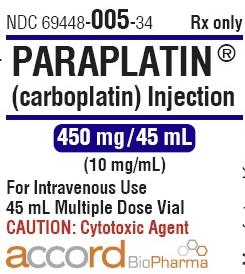Carboplatin Disease Interactions
There are 5 disease interactions with carboplatin.
Antineoplastics (applies to carboplatin) infections
Major Potential Hazard, High plausibility. Applicable conditions: Infection - Bacterial/Fungal/Protozoal/Viral
Because of their cytotoxic effects on rapidly proliferating tissues, antineoplastic agents frequently can, to varying extent, induce myelosuppression. The use of these drugs may be contraindicated in patients with known infectious diseases. All patients should be instructed to immediately report any signs or symptoms suggesting infection such as fever, sore throat, or local infection during antineoplastic therapy. Close clinical monitoring of hematopoietic function is recommended.
Carboplatin (applies to carboplatin) bleeding disorders
Major Potential Hazard, High plausibility.
The use of carboplatin is contraindicated in patients with significant bleeding. Carboplatin causes severe myelosuppression and dose-dependent thrombocytopenia. Patients should be instructed to immediately report any signs or symptoms suggesting bleeding such as petechiae, purpura, epistaxis, hemoptysis, hematuria, and melena. Close clinical monitoring of hematopoietic function is recommended.
Carboplatin (applies to carboplatin) myelosuppression
Major Potential Hazard, High plausibility. Applicable conditions: Bone Marrow Depression/Low Blood Counts, Fever
The use of carboplatin is contraindicated in patients with severe myelosuppression. Carboplatin induces dose-dependent leukopenia, thrombocytopenia, and anemia, which is cumulative and also dose limiting. Therapy with carboplatin should be administered cautiously in patients whose bone marrow reserve may be severely depressed by prior chemotherapy or irradiation, whose marrow function is recovering from previous cytotoxic therapy, or in patients with compromised renal function. Patients should be instructed to immediately report any signs or symptoms suggesting bone marrow suppression such as fever, sore throat, local infection, or bleeding. Peripheral blood counts should be frequently monitored during carboplatin injection treatment and, when appropriate, until recovery is achieved.
Carboplatin (applies to carboplatin) renal dysfunction
Major Potential Hazard, High plausibility.
Carboplatin is primarily eliminated by the kidney. Total body and renal clearance of carboplatin are reduced in patients with a creatinine clearance < 60 mL/min. Patients with impaired renal function are at increased risk for toxicity, particularly myelosuppression. Therapy with carboplatin should be administered cautiously in patients with compromised renal function. Clinical monitoring of renal function is recommended.
Carboplatin (applies to carboplatin) peripheral neuropathy
Minor Potential Hazard, High plausibility.
Mild peripheral neuropathy has been noted during carboplatin therapy and is characterized most frequently by paresthesias. Patients older than 65 years and/or previously treated with cisplatin appear to be at increased risk for peripheral neuropathy. There was no worsening of cisplatin symptoms in 70% of patients who received carboplatin as secondary treatment. Therapy with carboplatin should be administered cautiously in patients with or predisposed to neuropathy.
Switch to professional interaction data
Carboplatin drug interactions
There are 551 drug interactions with carboplatin.
More about carboplatin
- carboplatin consumer information
- Check interactions
- Compare alternatives
- Pricing & coupons
- Reviews (5)
- Side effects
- Dosage information
- During pregnancy
- Drug class: alkylating agents
- Breastfeeding
- En español
Related treatment guides
Drug Interaction Classification
| Highly clinically significant. Avoid combinations; the risk of the interaction outweighs the benefit. | |
| Moderately clinically significant. Usually avoid combinations; use it only under special circumstances. | |
| Minimally clinically significant. Minimize risk; assess risk and consider an alternative drug, take steps to circumvent the interaction risk and/or institute a monitoring plan. | |
| No interaction information available. |
See also:
Further information
Always consult your healthcare provider to ensure the information displayed on this page applies to your personal circumstances.


